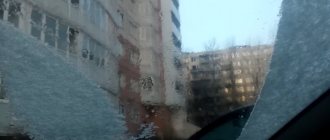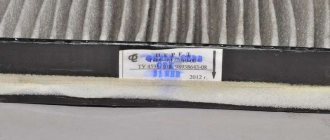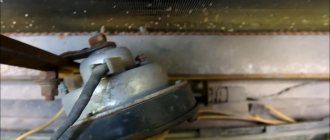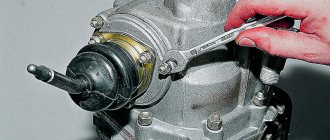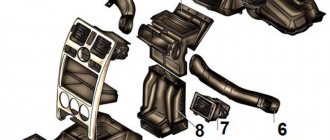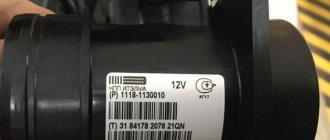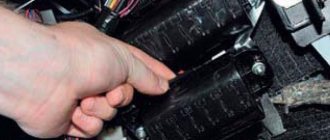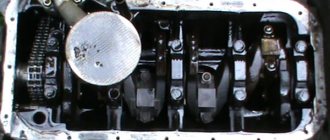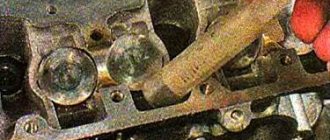About Lada Kalina
Having replaced the outdated “classics”, Lada Kalina embodied the expectations of many lovers of VAZ models.
It continued to be produced as a budget car option that the average Russian family could afford to buy. Today, cars of the Kalina family series are presented in 3 body variations: a station wagon called VAZ 21117, a VAZ 21118 sedan and a VAZ 21119 hatchback.
VAZ station wagon
All these car modifications are characterized by a large interior and compact shape. New-fangled design, body strength and modern technologies - all of these modifications of the Kalina family combine to the fullest.
Among the main advantages of the Kalina body are a wide variety of colors, rigidity and much more. But among the shortcomings, many note the insufficient level of sound insulation.
The world's first Kalina was released in 2004. A lot of time has passed since then. Owners of used Kalinas are often interested in the features of repairing individual body elements.
Typical faults
Repairing a Lada Kalina is not a very difficult task, you just need to know the main “pain points”. Significant problems are rare, but minor malfunctions are quite common. The clutch cannot boast of a high level of reliability and sufficient power reserve, regardless of the type of engine; it begins to fail after about forty thousand runs. The main problem is with the disk.
It is recommended to monitor the oil level - it begins to leak through the gaskets or burns on the piston rings. The instrument panel is equipped only with an oil pressure warning lamp, there is no dial indicator. Constant lighting of the lamp warns that the crankshaft may knock. Increased noise is often heard at the gearbox It is difficult to get rid of the humming noise; sometimes neither changing the bearings nor adding good quality oil will help. Noise can be present even in new cars. thermostat is another problem. Its valve can jam at any moment.
Replacing the cabin filter and oil
Repair and maintenance manual for Hyundai Accent
For dismantling, you will need a set of screwdrivers and a TORX wrench. First, pry off the plug, then unscrew the bolts. The hood is opened and the grille is removed. The cabin filter is located under the grille. The lid slides to the right and the filter is removed.
If necessary, clean the seat with a vacuum cleaner. Install the new filter by performing the steps in reverse order. It will take no more than 20 minutes to dismantle and replace this part. Upon completion of the repair work, turn on the heating unit. Foreign odors should disappear.
An equally important process is changing the oil in the Lada Kalina engine yourself. This process is carried out using a 17 key. For engines of 1.6 and 1.4 volume, about 3.5 liters of new oil will be required. First, open the hood of the vehicle. Then unscrew the filler cap. This is necessary to depressurize the corresponding system. Under the car body there is a drain plug, which must be unscrewed using a 17 key. A container is installed under the car into which the waste substance will drain.
Oil level control
The next step involves removing the oil filter. It must be removed carefully, placing some container under it. Then enough oil is poured into the new unit to keep it full. If the waste liquid leaves the system, you can tighten the drain plug. Install a new filter. After pouring oil into the system, check the fluid level. A probe is used for this. If necessary, add liquid. The process of changing the oil and the corresponding filter on Kalina takes 30 minutes. Upon completion, you need to start the engine and wait until the oil sensor lamp goes out.
Do-it-yourself repair of a Lada Kalina car is also required due to the uncomfortable interior. In this case, the trim is replaced and the vehicle is tuned. To eliminate creaking and engine noise in the cabin, you will need to lubricate the doors and check the engine's performance. It is a rigid structure, so to improve or replace it, you will need a car repair manual.
Advantages and disadvantages
The advantage of the 11183 engine is the cylinder head of the original design. However, it was subsequently further modified into the ICE 11186, adding volume to the combustion chambers. The downside is the generator belt tensioner - the drive is constantly over-tightened, a deflection of 10 mm is not ensured without slipping, so the belt life is reduced and it has to be changed more often. This defect was corrected only in the next version of the motor 11186.
The integrated catalytic collector assembly in the engine was initially unfinished:
- the tubes of the four channels are short;
- flows converge inside the block at almost one point;
- exhausts collide and create opposition to each other;
- the shape of the block did not allow changing the arrangement of the tubes.
Catcollector 11183
When installing the engine on the Lada Granta, the cabin heat exchanger was connected to the thermostat in series. All the coolant passed through it along a small circuit, the response temperature error was 5 degrees instead of the required 2 degrees.
Design Features
Auto repair school Articles, tips and tricks on do-it-yourself car repair and maintenance
The steering system of the Lada Kalina includes an electric power steering and a steering column that is adjustable in height and tilt. The steering mechanism is a steering rack with a variable transmission ratio. The rack engages with the engine crankcase through a gear having helical teeth, the pitch of which varies along the length of the rack. The figure shows the design of the Kalina steering rack.
The steering rack on Kalina is pressed against the gear by a spring. Friction is reduced by a plastic insert. The spring pressure is changed with an adjusting nut (the factory-set gap between the rack and the shaft is 0.1 mm). The second end of the rail rests against a plastic sleeve. Adjusting the gap helps eliminate knocking noises.
The steering system shaft is installed in bearings (one in the column bracket, the other in the electric booster housing). The column bracket is attached to the pedal bracket (front) and to the body bracket. The column bracket with the pipe is connected in the form of a hinge of two plates, which allows you to change the position of the steering wheel, and the range of movement is limited by the slots in the plates.
To fix the position of the pipe, there is a lever connected to the adjusting sleeve. It is screwed into a coupling bolt located in the slots of the plates. When you turn the lever, the bushing rotates, loosening the fixation of the plate, which allows you to change the position of the steering wheel. Springs between the plates and the bracket pull the pipe up when the fastening is loosened.
The steering system of the Lada Kalina has two tie rods and swing arms. The rod consists of external and internal tips and an adjusting threaded sleeve, which, when rotated, changes the length of the rod. The required adjustment of the rods is fixed with bolts. The rod is connected to the swing arm using an external tip that has a ball-type joint.
Kalina's electric power steering reduces the force applied to the steering wheel. It is assembled on the basis of an electric motor with a gearbox located under the steering system casing. The amplifier is controlled by an electronic unit that receives signals from sensors of vehicle speed, shaft rotation and steering torque.
The principle of operation of the amplifier is based on the fact that when the car is stationary, the torque on the steering shaft is the greatest, and when moving, it decreases with increasing speed. There is a power steering indicator on the dashboard.
https://youtube.com/watch?v=13qasRZk8gA
Disassembling the steering rack and repairing it when jammed
Lada Priora hatchback Logbook Steering rack repair
If steering rack repair is required, it begins with disassembling it. During repairs, a steering rack repair kit is used. Disassembly is carried out in a certain order. First, the adjusting nut is unscrewed, which sometimes requires considerable effort. Then the thrust bushing is removed.
If it is difficult to remove, you can use a mallet to lightly hit the rack body. The side plugs and boot are removed after cutting off the plastic fasteners. For preventative purposes, it is recommended to replace the boot with a new one in any case. The shaft is removed from the rack housing by hitting the body with a mallet.
Steering rack parts: 1 – rack bushing ring; 2 – rack support sleeve; 3 – steering gear housing; 4 – roller bearing; 5 – drive gear; 6 – ball bearing; 7 – retaining ring; 8 – protective washer; 9 – sealing ring; 10 – bearing nut; 11 – lock washer; 12 – boot; 13 – rack; 14 – protective cap; 15 – rack stop; 16 – sealing ring; 17 – retaining ring; 18 – stop nut; 19 – clamp; 20 – protective cover; 21 – inner tie rod end; 22 – connecting plate; 23 – locking plate; 24 – bolt securing the rod to the rack; A - mark on the boot; B - mark on the crankcase
Inside the freed cavity of the housing, a plastic sleeve will become noticeable, which can be removed using a screwdriver. It must be replaced with a new one from the repair kit. All old grease is removed from the cavity of the steering rack housing; the surface is thoroughly cleaned, washed and blown.
New lubricant is applied both inside and outside the housing
Lithol is used for this purpose. Particular attention should be paid to lubricating the gearing areas. All rack parts are inspected and, if necessary, replaced with new ones from the repair kit. If the steering wheel is jammed, it must be removed
This operation for Lada Kalina is carried out as follows.
First, the airbags are disconnected from the battery, their locks and clamps are loosened. The cushions are released and moved to the side. The two horn wires are disconnected. On the steering wheel mounting shaft, in the place marked with an arrow, a mark is made on the location of the steering wheel before it is removed.
The steering wheel nut is loosened (but not completely unscrewed). When the steering wheel swings from side to side, it is tightened until it stops against the nut. Then you should align the car's wheels and ensure that the steering wheel is straight. The pin is removed and inserted into the switch block below the steering wheel.
Brief history of Lada Kalina
Development of the new product began back in 1993. Five years later, as part of the project, the model received the name Lada Kalina, which is still used today. Before the car went into production in 2004, prototypes of various body styles were shown in 1999, 2000 and 2001.
First generation Lada Kalina
Production of the first generation model lasted from 2004 to 2013. It was accompanied by the gradual development of the car and the improvement of its equipment. From the very beginning, the model was equipped with a 1.6 liter 8-valve engine , but already in 2007 it was replaced by a 16-valve version with more power.
From time to time, Lada Kalina cars were withdrawn after defects were discovered, but this did not prevent them from taking 4th place in popularity in the manufacturer’s territory. Despite promises of significant modernization, the production of representatives of the first generation gradually ceased from 2011 . It was here that AvtoVAZ stopped producing the sedan model.
Second generation Lada Kalina
On May 16, 2013, production of the second generation began. The car received 2 body options: “hatchback” and “station wagon”. It has completely changed in appearance , the equipment has been improved and new options for more powerful engines that meet the EURO-4 standard have appeared.
Source
Approximate cost of repair work on the Kalina body at a service station
Body Kalina station wagon Lada
These are the prices offered today in various repair services.
| Replacement, removal and installation of body parts | Price, rubles |
| Hood replacement (removal/installation) | 1800 |
| Front fenders (removal/installation) | 1600 |
| Front doors (removal/installation) | 2200 |
| Rear doors (removal/installation) | 2000 |
| Bumpers (removal/installation) | 1800 |
| Sedan trunk lid (removal/installation) | 1900 |
| Replacement of load-bearing body elements | Price, rubles |
| Roof panel | 9000 |
| Wing | 14 000 |
| Spar | 11 000 |
| Door threshold | 9000 |
| Door pillar | 8000 |
| Slip works | Price, rubles |
| Installing the car on a slipway to remove reference points to check the geometry of the body | 4000 |
In principle, the prices are not that low. It would be better to learn how to replace (which is much easier) or repair it yourself. We are not talking about competently taking body dimensions to compare geometry. This, of course, should be done only with high-quality equipment, which is almost impossible to provide in a garage workshop.
On the other hand, useful information about the geometric dimensions of Kalina’s bodies will be presented below, which will make it possible to remove them yourself using a regular tape measure.
Watch a video about problem areas of the Lada Kalina body
Basic information about LADA Kalina
LADA Kalina has been produced since 2004; production of the popular second-generation car began in 2013. Kalina-1 is available in three body types: hatchback (model 1119), sedan (model 1118), station wagon (model 1117). There are cars available with petrol engines of three modifications: a 1.4-liter 16-valve engine with a power of 89 hp. s., 1.6-liter 8-valve engine producing 81 hp. s., 1.6-liter 16-valve engine producing 98 hp. With. The LADA Kalina-1 has only a manual transmission with five gears. The front axle has a classic MacPherson suspension, the rear axle has a beam with stabilizer, springs, and shock absorbers.
Adjusting the spring and power steering
Very often, the cause of a knocking sound when turning the steering wheel is a weakening of the pressure spring. It provides the required force for pressing the steering rack gear against the main shaft gear, which is set at the factory by adjusting and fixing the spring. As the vehicle is used, the spring loses its elasticity and relaxes.
In order to increase the pressing force of the spring, it is necessary to tighten it, which is done after disconnecting the steering mechanism, but without removing the steering rack. Repairing the steering rack in this case consists of setting the required gap between the rack and the shaft gear. The steering rack is installed in the middle position and is secured against movement.
The rubber plug is removed, and the indicator probe is placed in the hole of the stop adjusting nut so that it comes into contact with the rack stop. It is better to use a dial indicator. Then, turning the gear shaft that pushes the stop, the indicator measures the size of the stop's movement. The length of movement should not exceed 0.05 mm.
If this value is exceeded, it is eliminated by turning the adjusting nut. The steering rack is fixed in the position corresponding to the required clearance, and the ease of rotation of the pinion shaft is checked within the entire possible movement of the rack.
The adjustment nut is rotated using a special wrench for adjusting VAZ steering racks. It is not recommended to tighten the nut too much, which can have a negative effect when turning the steering wheel at maximum speed. If there is play when turning the steering wheel, the spring can be tightened by practically selecting the correct force.
In this case, initially the adjusting nut is turned by 20-25°, and the presence of knocking is checked when the rack is turned. If the noise is not eliminated, then tighten the nut again by 10-15°, and so on until the knocking noise is eliminated. If tightening the spring does not help, the steering rack needs to be repaired.
Adjusting Kalina's electric power steering is best done after removing the steering rack, but it can be done without dismantling with some inconvenience. The car is placed on the repair pit so that from below there is access to the mounting of the front part of the amplifier.
The clamping nut is tightened by turning clockwise from below, and when tightening the nut from above, respectively, counterclockwise. For the purpose of prevention, you should check the condition of the oil seal, since when the steering wheel is turned too much, the oil seals quickly wear out. At the same time, all elements are lubricated, especially the steering rod boots.
Typical diseases of Lada Kalina-1
Major breakdowns with the car do not happen often, but there are plenty of various unpleasant little things. The clutch on a VAZ car is not highly reliable and has a long service life, regardless of the engine type, and it can fail after 40-50 thousand kilometers. The main cause of failure is a collapsed clutch disc.
It is necessary to constantly monitor the oil level in the engine - it can leak through the gaskets and escape through the piston rings. On the instrument cluster there is only an oil pressure warning lamp; there is no dial indicator. When the indicator lights up constantly, it may be too late - the crankshaft will knock.
A well-known disease of all VAZ gearboxes is increased noise. It is difficult to get rid of gearbox noise; in some cases, even replacing bearings or filling with high-quality transmission oil does not help. Gearboxes also whine on new cars, so AvtoVAZ has modified the transmission more than once.
Also, starting with the “eights” and “nines”, the thermostat in the engine was considered a problematic part, and the valve in it could get stuck in any position. It's unpleasant if the engine doesn't warm up to the required operating temperature, but when the engine overheats, it's even worse.
Three main problems most often arise in the electrical system of the Lada Kalina-1:
If the ignition coil is punctured, either the first and fourth or the second and third cylinders stop working in the engine. The ESP cable breaks due to the fact that it jumps off its guides.
The reason for the crunching of outer CV joints is a lack of lubrication; thrifty factory workers do not provide enough of it. As a result, intensive wear of the hinges occurs, and the “grenade” has to be replaced.
A broken timing belt is always unpleasant, but if on an 8-valve 21114 you can change the belt drive and move on, then on engines 11194 and 21126 the valves bend from the oncoming impact with the pistons, and repairs are quite expensive. A break can also occur due to a jammed water pump, so if the pump becomes noisy, it needs to be replaced urgently.
How to change rear pads on Kalina
The brake systems of different variations of the LADA Kalina are distinguished by the absence or presence of an anti-lock braking system. Changing the rear brake pads of a Kalina with or without ABS is equally simple. The only difference is that in the first case, before dismantling the pads, you must disconnect the wires from the sensors so as not to damage them. To prevent brake fluid from spilling out of the reservoir and getting on the paintwork or rubber parts of the Kalina when replacing the pads, it is necessary to take some of the fluid from the reservoir into a prepared container. This operation should be carried out only when the brake fluid level in the reservoir is close to the maximum level. Replacement of the rear pads is carried out one by one: first from the left, then from the right side (or vice versa, the order is not important here). Some operations, for example, loosening the tension of the handbrake cable or adjusting it, are more convenient to carry out from the inspection pit or using a lift. Therefore, the work must be performed in an equipped garage.
Replacement of rear brake pads of LADA “Kalina” is carried out as follows:
- install wheel chocks under the front wheels;
- lower the handbrake lever all the way down to reduce the tension on the Kalina handbrake cable as much as possible;
- by rotating the adjusting bolt under the bottom of the car, loosen the handbrake cable;
- use a wheel wrench to loosen the wheel bolts;
- jack up the wheel;
- Unscrew the wheel bolts with a wheel wrench;
- remove the rear wheel;
- unscrew the pins that simultaneously serve as fastening of the brake drum and guides for installing the wheel;
- Use a wire brush to clean the rear wheel hub where the drum fits;
- treat the place where the drum fits on the hub with WD-40, wait according to the instructions; tap the drum with a rubber hammer to “break” it out of place;
- evenly screw the M8 bolts into the mounting holes of the drum, pulling the latter off the hub;
Attention: if you press the brake pedal with the drum removed, the piston of the brake cylinder may fall out, which will lead to depressurization of the circuit, the need to bleed the brakes or even replace the brake cylinder
- check the condition of the brake drum: it should not have chips, uneven wear, cracks or marks;
- if necessary, replace the brake drum with a new one;
- bring together the rear Kalina pads using pry bars (mounting blades);
- pry the end of the upper spring, which tightens the pads, with a slotted screwdriver and remove it from engagement with the pad;
- remove the upper spring from the second block, put it aside;
- remove the lower tension spring using a screwdriver or pliers;
- remove the “front” block located closer to the front of the car;
- remove the spacer bar installed between the pads;
- remove the end of the parking brake cable from the hook of the rear shoe spacer lever;
- using pliers, disengage the spring holding the second block;;
- remove the block located closer to the rear of the car;
- undo the pin securing the spacer lever;
- remove the spacer lever;
- clean the brake mechanism parts from dirt;
- secure the spacer lever to the new block;
- pin the finger;
- install the “front” brake pad;
- put the spacer bar in place;
- install the “rear” block by putting the lower tension spring on it;
- put the end of the handbrake cable on the spacer lever of the block;
- Using a screwdriver or pliers, hook the lower and upper tension spring onto the pads;
- reinstall the brake drum;
- tighten the guide pins holding the drum;
- secure the wheel with wheel bolts;
- lower the jack so that the wheel is on the ground;
- Use a wheel wrench to tighten the wheel bolts.
Then the same operations must be done on the second wheel. Now you know how to change the rear pads on a Kalina.
Remember: after replacing the rear pads, you need to adjust the handbrake of the LADA Kalina.
Do-it-yourself car repairs
“Kalina” is a simple car, so the driver can eliminate most of the damage himself. For example, you can fix the following problems on your own:
Repairing the LADA Kalina car yourself must be carried out in accordance with the instructions, using only good car mechanic tools, if you need to use special equipment and pullers for repairs.
How to change a constant velocity joint?
You can replace the outer CV joint in a Lada Kalina car without using a lift or pit, but you will need to place the car on a flat surface. Replace in this way:
How to remove air from the cooling system?
An air lock in the cooling system can appear for a number of reasons, and first of all, the stove in the cabin stops blowing heated air, the temperature rises, and antifreeze boils. When the upper and lower pipes are compressed, a void is felt due to the lack of coolant in them. Often, “airing” occurs as a result of changing the heater radiator; removing air from the system is sometimes too problematic. But you can try installing an auxiliary tee on the lower pipe of the heater under the hood, and lead a new hose into the expansion tank at the top; you need to install a plug in the lower pipe from the tank to the lower radiator tube.
How to determine if the Lada-Kalina muffler is faulty
To find a faulty exhaust system, you don’t have to be a car mechanic or have extensive experience in car repairs. To identify problems, you need to act in the following sequence:
Pay attention to noises that are made while driving. If the muffler is faulty the sound will be quite loud
Extraneous noises also indicate problems with the exhaust system. Raise the car with a jack or drive onto an overpass and inspect the system body. A working device should have no holes or rust. The presence of traces of corrosion indicates that, most likely, there is a problem with the housing. While driving, you need to monitor the color of the exhaust: the periodic appearance of black and dense smoke will indicate that there are problems with the exhaust system. Start the engine and press the gas pedal for several minutes. Then turn off the ignition and check the engine temperature. During this time it should not get very hot. If it has risen significantly, it means that there are problems in the performance of the mechanism.
Quite often, the muffler body is exposed to corrosion, which leads to the appearance of holes and, as a result, a loud exhaust sound.
Malfunctions of various types can occur with the exhaust system, but the most common is unreliable installation of muffler elements. As a result of poor-quality connection, the unit quickly fails. In addition, common malfunctions include:
- loss of tightness as a result of burning out of individual elements (corrugations, gaskets);
- catalyst problems;
- mechanical damage;
- exposure to corrosion, which leads to the appearance of holes.
One of the malfunctions of the Lada-Kalina exhaust system is burnout of the corrugation
Causes of breakdowns, as well as ways to eliminate them
It doesn’t matter what configuration the car is, be it a sedan or a hatchback, each of them needs regular inspections during operation. However, few car owners know about this. There is an opinion that during operation a car only needs a technical inspection, but this is not the case.
If you carry out regular inspections and identify breakdowns in the early stages, you can save yourself a lot of work and costs in the future.
Repair of Lada Kalina is based on a number of typical breakdowns, which can be avoided without making certain mistakes during operation. Among them:
This is the main list of problems that may require repairing Kalina. If you follow all the recommendations, there will be many fewer problems.
Features of repair work on Lada Kalina
- It must be remembered that the machines are produced with two types of engines, and most of the units and components that are installed on the machine are completely unified.
- If you are interested in repairing VAZ Kalina cars, it is strongly recommended that all work be carried out in strict accordance with the labor safety instructions and labor safety rules for motor vehicles.
- It is allowed to use only certified tools and equipment during repair work on the Lada Kalina, which in terms of functional characteristics correspond to those specified in the technological instructions. Compliance with this condition makes the work safe, high-quality, and productivity is achieved as efficiently as possible.
- The Lada Kalina repair instructions and its content will directly depend on the nature and location of the breakdown.
- Remember that if the repair work you carry out is related to starting the engine or you are replacing the fuel filter on Kalina, exhaust gas extraction must be carried out without fail.
- When replacing and adding oils or operating fluids, you can use only those materials that are specified in the appendix on the consumption rates of auxiliary and basic materials in the direct manual. Otherwise, replacing the cabin filter will become too frequent a problem. You will get a similar result if you add or replace coolants with mixtures of different brands.
- It is strongly recommended that any repair work be carried out in a well-ventilated area, especially when it comes to painting machine elements.
In general, the repair work you carry out may be associated with such vehicle shortcomings as:
- Uncomfortable interior. In this case, the owner may express a desire to change the trim and pump the car himself.
- Creaking in the cabin and engine noise when driving. In this case, from time to time you will have to lubricate the doors and check the condition of the engine.
- The suspension is too stiff, therefore, over time it will be necessary to carry out work to improve the suspension or replace it.
- If you need to replace the thermostat, it is highly recommended that you use the step-by-step instructions for carrying out the repair work in question.
- The problem may occur when reverse gear is engaged.
- Most owners claim that the most active manifestation of minor breakdowns begins after one hundred thousand kilometers.
Do-it-yourself car repairs
“Kalina” is a simple car, so the driver can eliminate most of the damage himself. For example, you can fix the following problems on your own:
Repairing the LADA Kalina car yourself must be carried out in accordance with the instructions, using only good car mechanic tools, if you need to use special equipment and pullers for repairs.
How to change a constant velocity joint?
You can replace the outer CV joint in a Lada Kalina car without using a lift or pit, but you will need to place the car on a flat surface. Replace in this way:
Knock in the front suspension of Lada Kalina
Many motorists dread the day when strange knocking noises appear in the suspension, especially the front suspension, which increases with increasing speed. Of course, there is reason to worry, but at the same time, a car’s suspension is a strong and reliable unit that will clearly withstand a few more kilometers to a service station or garage, where it can be diagnosed.
There are four main reasons for the occurrence of knocks and squeaks in the front suspension of the Lada Kalina. Of the three possible causes of knocking, two of them can be eliminated independently.
So, the first reason why a knocking sound may occur in the suspension is the quality of the road surface. Yes, suspensions, even the most ideal and new ones, can squeak and knock on a bad road, even if this has not been observed before. To test this theory, you should drive onto a well-paved road and drive a few hundred meters; if there is no knocking, everything is fine with the suspension; if not, look at the second reason.
The second reason for the knocking sound, if it is accompanied by vibration in the steering wheel, is a malfunction of the steering, or rather the steering rack, or thinning of the brake discs. If the discs can be replaced independently, then in the case of steering, if you are not a level 80 mechanic, it is better not to flirt with it right away bring the car to the service station.
The third reason is the springs that have lost their tone, as a result of which the car body practically hits the suspension. You should not deal with this problem on your own - it is better to immediately take the car to a service station or service center, since self-repair may seriously damage the front suspension strut.
The fourth reason is a worn-out silent block, which is designed to dampen vibrations and knocks when driving. You can replace the silent block yourself; see the step-by-step replacement of the silent block in the Lada Kalina mono in the next paragraph.
Replacing front suspension silent blocks
Replacing the silent blocks of the Lada Kalina front suspension is necessary after 15-17,000 km, otherwise noises and knocks may be observed when driving. In most cases, the loss of its functions is observed after 15-17,000 km; knocking noises that appeared during this period of kilometers are a problem of faulty silent blocks.
Silent block
The silent block replacement diagram looks like this:
- The machine is placed above a hole or ditch in order to be able to comfortably see the entire suspension. The movers are fixed by the wheels, we put the car itself on the handbrake, then it’s worth checking again that the car is stationary.
- Use a jack to lift the car and remove the front wheel.
- After this, you should fix the bolts of the ball joint with your hands, after which its fastenings are removed.;
- The SPU nut is unscrewed, before this the ball-type support is knocked out into the lower part, after these manipulations the bolts are removed.
- After removing the bolts, the sleeve blocking the lever is pulled out. After pulling out the bushing, the lever is pulled out.
- There are marks on the lever that indicate the direction of installation of new silent blocks; this should be taken into account when installing new blocks.
- The silent blocks must be lubricated at the point of contact with the lever. Using a vice or pliers, apply pressure to the blocks until they fall off.
The diagram is approximate and is for informational purposes to understand how many manipulations need to be made to replace silent blocks.
Basic information about LADA Kalina
LADA Kalina has been produced since 2004; production of the popular second-generation car began in 2013. Kalina-1 is available in three body types: hatchback (model 1119), sedan (model 1118), station wagon (model 1117). There are cars available with petrol engines of three modifications: a 1.4-liter 16-valve engine with a power of 89 hp. s., 1.6-liter 8-valve engine producing 81 hp. s., 1.6-liter 16-valve engine producing 98 hp. With. The LADA Kalina-1 has only a manual transmission with five gears. The front axle has a classic MacPherson suspension, the rear axle has a beam with stabilizer, springs, and shock absorbers.
Typical faults of LADA Kalina-1
Significant malfunctions with Kalina rarely occur, but there are a lot of various undesirable trifles. The car’s clutch is not very reliable and has an impressive service life, regardless of the type of engine, so it can malfunction after 40-50 thousand kilometers. The main source of malfunction is a broken clutch disc.
You need to constantly monitor the oil level in the engine - sometimes it leaks through the gaskets or burns through the piston rings. On the instrument panel there is only an oil pressure warning light, but there is no dial indicator. If the indicator lights up all the time, there is a possibility that the crankshaft is knocking.
A common malfunction of VAZ gearboxes is increased noise. It is difficult to get rid of the humming of the gearbox; sometimes neither replacing the bearings nor refilling with first-class transmission oil comes to the rescue. The transmission is noisy even in new cars, because of this the Volzhsky Automobile Plant has repeatedly completed the transmission.
A problematic element since the days of the VAZ 2108 and VAZ 2109 has been the thermostat in the engine, moreover, the valve in the thermostat was capable of jamming in any position. It's annoying when the engine doesn't heat up to the required operating temperature, but if the engine overheats, it's more problematic.
Electrical problems on LADA Kalina appear mainly of three types:
When the ignition coil sparks, the first and fourth cylinders or the second and third cylinders stop functioning. The ESP cable breaks when it falls off the guides.
The main source of cracking noise in outer CV joints is insufficient lubrication; At the factory, in order to save money, they put it in sparingly. The consequence of this is severe wear of the hinges, and as a result, the “grenade” needs to be replaced.
A broken timing belt is a very annoying problem. And if on the 8-valve engine 21114 it is possible to change the belt drive and move on, then on engines 11194 or 21126 the valves bend from the oncoming push from the pistons, repairs will be quite expensive. In addition, a break can occur through a jammed water pump, because of this, if the pump begins to make noise, it must be replaced immediately.
Front suspension device
The front suspension of the Lada Kalina is independent on MacPherson struts. This suspension is the most common in the automotive world for its price and acceptable characteristics for this price. Previously, Lada used this suspension, for example, in Lada Samara, but it was much poorer in equipment than MacPherson, although it was 90% similar to it.
So, the Lada Kalina suspension consists of the following components:
- Stabilization bar;
- Brackets for securing the stabilization rod;
- Cross arm mountings;
- Front suspension arm;
- SPU (anti-roll bar) bases;
- Telescopic front suspension strut;
- Ball-shaped supports;
- Kulaga;
- Longitudinal stretch;
- Stretch mounts.
